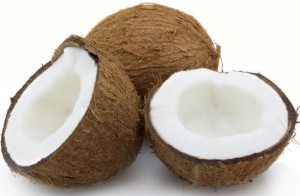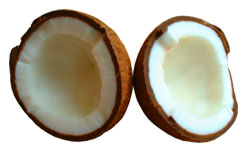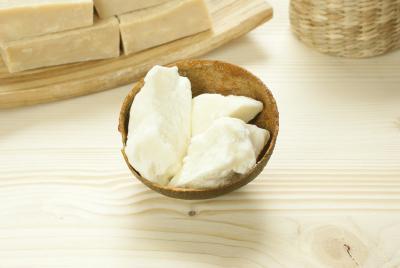

COCONUT


The coconut tree (palm famıly).Coconut found throughout the tropic and subtropic area, the coconut is known for its great versatility as seen in the many uses of its different parts. Coconuts are part of the daily diets of many people. Coconuts are different from any other fruits because they contain a large quantity of "water" and when immature they are known as tender-nuts or jelly-nuts and may be harvested for drinking. When mature, they still contain some water and can be used as seednuts or processed to give oil from the kernel, charcoal from the hard shell and coir from the fibrous husk.
The oil and milk derived from it are commonly used in cooking and frying; coconut oil is also widely used in soaps and cosmetics . The clear liquid coconut water within is drinkable. The husks and leaves can be used as material to make a variety of products for furnishing and decorating. It also has cultural and religious significance in many societies that use it.
There are several different ways to enjoy fresh coconuts, which can be young or mature. Young coconuts have either a green shell or a white "husk" if the outer shell has been removed while mature coconuts are the more familiar-looking brown, hairy variety. The nutrients and physical characteristics change as a coconut matures. Young coconuts have more water and soft, gel-like meat, and mature coconuts have firm meat and less water.

Coconuts can actually grow right into the soand on the beach
It has been identified that the coconut palm is crucial to the economy of the coastal belt of Ghana but its importance is declining.
At Obronikrom in the Shama District of the Western region, fishermen recount times when they sat under coconut trees and fixed their nets.
During the period, young boys used to pluck the coconut fruits.
They used to drink the fresh water for refreshment and ate the white food referred to as meat.
Women made income by extracting oil from the dried meat of the coconut called copra but today there are no coconut trees along the beach.
Business opportunity

Some farmers took advantage of the business opportunities to improve their living condition.
They started growing coconut palm which is believed to have been brought to West Africa by the Portuguese missionaries over 500 years ago.
Soon the cultivation, processing and marketing of coconut became the order of the day.
Though the coconut palm is believed to have been introduced to Keta in the Volta region, located in the south eastern part of the country by the early missionaries, the then British colonial government showed interest in the crop and in 1910 promoted its large-scale cultivation along the coastal strip of the country.
With time, coconut cultivation began to thrive in four main coastal regions, Volta, Western, Central and Greater Accra where the soil type, mostly sandy soil was not suitable for other cash crops.
Coconut has been cultivated as a cash and food crop and women, children as well as young men make income by selling the fresh drinking fruits

The Coconut Meat, the white portion of the nut, offers more than just sustenance. The coconut is considered a highly nutritious food. The white meat also contains coconut oil the tropical natives use for cooking.
The shell, husk, roots of the tree, fronds, flowers, and wood of the trunk also become useful products. Charcoal filters used in gas masks and cigarettes are made from coconut shells that are burned, leaving pure carbon behind. Charcoal has the ability to trap microscopic particles and impurities and prevent absorption. Charcoal made from coconut shells produces filters of exceptional high performance.
One third of the coconut's make-up is the hairy husk that is soaked in salt water until it is soft enough to spin into rope or twine that is known for its durability. The rope, called coir but pronounced coil, is highly resistant to salt water and does not break down like other fibers including hemp.
The coconut husk has household practicality in tropical countries where coconuts are part of almost everyday cuisine. The husk provides fuel for cooking as well as fiber for making clothing.
Coir is also used to make mats. Another byproduct of the coconut husk is coir dust used in making fertilizer and plastic-board insulating material.
Travelers to tropical countries find a host of native crafts woven from the fronds of the coconut palm into hats, baskets, fans, brooms, little animals, belts, and chairs. In the past natives even wove the roof thatch of their homes from coconut palm leaves. Coconut tree roots were also put to practical use by boiling them down to create a dye.
Coconut oil provides diesel fuel and is also used for lighting and candle making. Coconut shells are made into buttons, form a base for decorative carvings, and are burned for fuel.
Women use coconut oil as hairdressing and as a lotion for the body. They also cook with coconut oil.

Coconut Milk is derived from the flesh of the coconut. It is not the liquid that can be drained out from a coconut that has been punctured, although many people assume this. Getting coconut milk from a coconut requires some processing, but the ingredient is also available in cans or bottles
Water from a young coconut not only provided a refreshing drink in the steamy equatorial countries, but in times of medical emergency it was used as a substitute for glucose. During World War II young coconut water became the emergency room glucose supply when there was no other sterile glucose available. Within a clean self-contained vessel, the coconut water is free of impurities and contains about two tablespoons of sugar.
Coconut Oil

Coconut Oil Commonly used as a nutritional supplement, coconut oil is also functional as a skin moisturizer and appears in many natural skin care products. Produced predominately in Southeast Asia, coconut oil is used as a dairy butter replacement, and is a
Coconut Butter

Coconut Butter skin exfoliant. Comprising both fat and fiber, coconut butter has a harder texture than coconut oil and should not be used for frying because it burns easily. When used in cooking such as candy making, coconut butter is melted at very low temperatures to prevent burning.
The benefits of using cocoa butter on hair are increased manageability and moisture. Cocoa butter can help prevent hair loss due to breakage or an inherently fine texture. It can also help alleviate scalp itching and irritation, and may help prevent chemical damage.
Individuals with fine hair might benefit from using cocoa butter, which can infuse volume and strength into the strands if used regularly. While the benefits are temporary, regular periodic use of the product can help fine hair appear healthier and more lustrous.
Those with damaged or dry hair may benefit immensely from using cocoa butter. Since it is a fat, it can be used to replenish lost oils due to chemical processes, such as perms and colorings. Using cocoa butter on hair can improve the texture and feel of damaged hair while repairing some of the damage incurred through the use of styling aids. It may also be able to temporarily correct issues with unmanageable, frizzy and flyaway hair.
Hair loss sometimes occurs as the result of damage incurred from hair bleaching and dyes. Cocoa butter can help prevent some of this hair loss by strengthening the hair shaft. Hair becomes less breakage prone once it is infused with adequate moisture